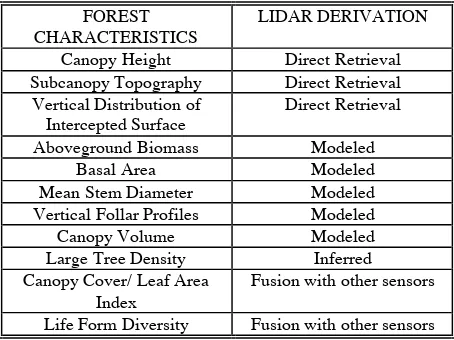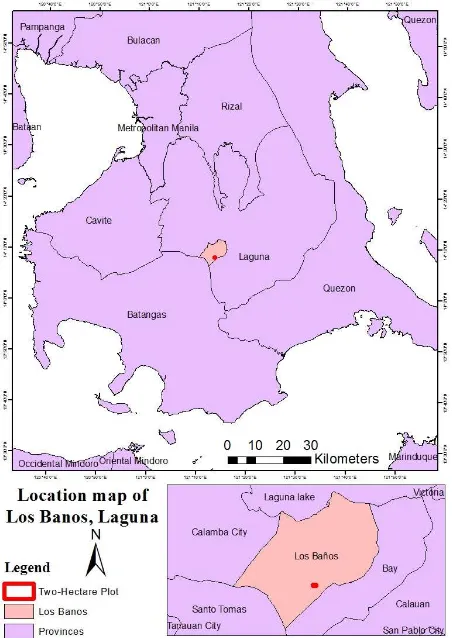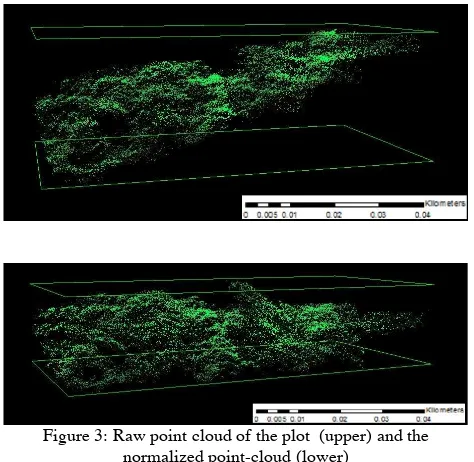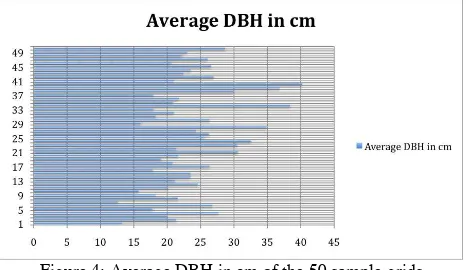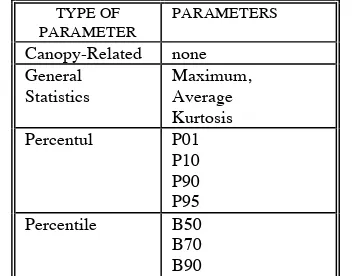ESTIMATING DBH OF TREES EMPLOYING MULTIPLE LINEAR REGRESSION OF
THE BEST LIDAR-DERIVED PARAMETER COMBINATION AUTOMATED IN
PYTHON IN A NATURAL BROADLEAF FOREST IN THE PHILIPPINES
C. A. G. Ibaneza,*
, B. G. Carcellar IIIa
, E. C. Paringita
, R. J. L. Argamosaa
, R. A. G. Faelgaa
, M. A. V. Posileroa
, G. P. Zaragosaa , N. A. Dimayacyaca
a
University of the Philippines- Training Center for Applied Geodesy and Photogrammetry- Diliman, Quezon City- (i.carlynann, bgcarcellar, paringit, regi.argamosa, regi.argamosa, reginefaelga, markposi, gio.zaragosa, nancydimayacyac)@gmail.com
Commission VIII, WG VIII/7
KEY WORDS: DBH Estimation, ALS, Multiple Linear Regression, Python, Broadleaf Forest, Forestry
ABSTRACT:
Diameter-at-Breast-Height Estimation is a prerequisite in various allometric equations estimating important forestry indices like stem volume, basal area, biomass and carbon stock. LiDAR Technology has a means of directly obtaining different forest parameters, except DBH, from the behavior and characteristics of point cloud unique in different forest classes. Extensive tree inventory was done on a two-hectare established sample plot in Mt. Makiling, Laguna for a natural growth forest. Coordinates, height, and canopy cover were measured and types of species were identified to compare to LiDAR derivatives. Multiple linear regression was used to get LiDAR-derived DBH by integrating field-derived DBH and 27 LiDAR-derived parameters at 20m, 10m, and 5m grid resolutions. To know the best combination of parameters in DBH Estimation, all possible combinations of parameters were generated and automated using python scripts and additional regression related libraries such as Numpy, Scipy, and Scikit learn were used. The combination that yields the highest r-squared or coefficient of determination and lowest AIC (Akaike’s Information Criterion) and BIC (Bayesian Information Criterion) was determined to be the best equation. The equation is at its best using 11 parameters at 10m-grid size and at of 0.604 r-squared, 154.04 AIC and 175.08 BIC. Combination of parameters may differ among forest classes for further studies. Additional statistical tests can be supplemented to help determine the correlation among parameters such as Kaiser-Meyer-Olkin (KMO) Coefficient and the Barlett’s Test for Spherecity (BTS).
1. INTRODUCTION
Proper forest resources assessment and management highly depends on accurate data gathering of tree inventories in an authentic ground survey to get detailed and up-to-date forest characteristics and attributes. The needed forest information are often based on species name, diameter-at-breast-height (DBH), basal area, merchantable height, total height and, in some cases, age. The most significant of these characteristics, and also the focus of this paper, is the DBH since other significant attributes like biomass and carbon stock are both derived by using allometric equations with DBH. DBH is obtained by measuring the diameter of the trunk at 1.3 meters above the ground. This method is too intensive and costly to conduct when applied in large areas. (Kankare,2015)
LiDAR is a breakthrough in forestry application. It has the capacity for direct calculation and estimation of important forest characteristics such as canopy height, canopy cover, stand volume, basal area and above ground biomass. However, Airborne LiDAR Scanning (ALS) is capable of directly measuring forest characteristics based on height but not DBH.
1.1 LiDAR Technology in Forestry
LiDAR Technology is a remote sensing method that uses light in the form of pulsed lasers that measure the roundtrip time for a pulse of laser energy to travel between a sensor and a target. These light pulses are recorded by the airborne system. When combined with other recorded data, it generates precise, three-dimensional information about the shape of the earth and its surface characteristics. (NOAA, 2015)
The pulse of energy strikes the canopy and the ground and goes back to the sensor. Canopy height, one of the more straightforward parameters, is calculated by subtracting the elevations of the first and last returns from the LiDAR signal. Since DBH is not height-quantifiable, it cannot be derived directly. However, vertical distribution of points from captured surfaces provides basis for estimating other important canopy descriptors such as DBH. (Dubayah, no date)
FOREST CHARACTERISTICS
LIDAR DERIVATION
Canopy Height Direct Retrieval Subcanopy Topography Direct Retrieval Vertical Distribution of
Intercepted Surface
Direct Retrieval
Aboveground Biomass Modeled
Basal Area Modeled
Mean Stem Diameter Modeled
Vertical Follar Profiles Modeled
Canopy Volume Modeled
Large Tree Density Inferred Canopy Cover/ Leaf Area
Index
Fusion with other sensors
Life Form Diversity Fusion with other sensors Table 1: Potential Contributions of LiDAR Remote Sensing in
Forestry Application (Dubayah, no date)
DBH of a particular area. Multiple linear regression models are developed using the plot characteristics as predictor variables to get the DBH of other area of interest. Field-measured diameter distributions are linked to the areas of interest based on the similarity of point-cloud-derived metrics measurements of individual trees and their attributes directly from the ALS point cloud. (Kankare, 2015)
A related study has also undertaken research that focuses on derivation of information from LiDAR data. In the study by Argamosa (2015) the average diameter at breast height of a broadleaf forest was estimated using linear and log-linear regression. A field validation site was established at 20m, 10m and 5m grids and tree inventories were also collected. Using 27 LiDAR parameters, estimation was made for both linear and log-linear regression at different grid sizes. All three grids showed promising results in estimating DBH. Linear regression analysis showed an r-squared of 0.72, 0.083, 0.70 for 20x20m, 10x10m and 5x5m grids, respectively. For the log-linear regression, 10x10m showed the highest r-squared at 0.67 followed by 20x20m at 0.56 and 5x5m grid at 0.05. The estimation was proved best at the Linear Regression using the 10x10m grid.
This paper would focus on using the 10x10m grid and linear regression as standards for DBH estimation. It aims to identify if all the 27 parameters contribute to the accuracy of estimation. The best parameter combination would be identified using combination of matrices generated by the python script.
1.2 Linear Regression and Python Programming
Regression falls under the category of supervised machine learning. Machine Learning is a study in computer science that involves pattern recognition and algorithm construction from basic raw dataset to create a model that makes predictions on other data, while supervised learning bases its algorithm construction by providing the computer the values of both dependent and independent variables.
Under this category are the two most prominent model generation methods, Regression and Classification. Regression estimates the outcome of the dependent variable based on the relationships, while classification identifies group membership of each sample through pattern recognition and user defined limits of each class.
Linear Regression is used to identify the effect of each parameter on the response variable or the dependent variable. It assumes all the parameters or the independent variables have a linear relationship to the dependent variable. The main objective is to determine the magnitude of effect of a feature in the final computation of the response.
On the other hand, python is a high-level programming language that is commonly used in scientific computations like machine learning. High-level language is easier to read and write. It is portable and can be run on different computers with less or no modifications.
2. MAIN BODY 2.1 Study Area
The study area is located at Mt. Makiling, Laguna at 14° 8’ North and 121° 2’ East and lies within 65 km of Metro Manila. The Mount Makiling Forest Reserves is an ASEAN Heritage
Park that spans a total of 4,224 hectares and is managed by the Makiling Center for Mountain Ecosystems under the College of Forestry and Natural Resources of the University of the Philippines- Los Baños. It covers the municipalities of Los Baños, Calamba and Bay in Laguna Province and the municipality of Sto. Tomas in Batangas Province. (MCME, 2015) The study area represents a mid-mountain Dipterocarp forest. At its present stage of forest development, it is vigorously regenerating secondary Dipterocarp forest stemming from years of logging during the Spanish period. Figure 1 shows the location of the plot with respect to Laguna province and its neighboring provinces.
2.2 LiDAR Acquisition
The LiDAR data was obtained using Optech Airborne Laser Terrain Mapper (ALTM) Pegasus acquired on March 12-18, 2014. The flying height for this flight is 1,100m above mean sea level and with a pulse density of 1.19 pulse/mand a planned point density of 2 pulses per square meter.
Figure 1: Location Map of the 2-hectare forest plot at Mt. Makiling, Los Baños, Laguna
2.3 Field Measurements
The inventory includes the establishment of a two-hectare plot subdivided into 150 grids each with a dimension of 10x10m. All trees within the plot with DBH greater than 10 cm are geotagged. The height and DBH of these selected trees were also recorded. Figure 2 shows the LAS File (LiDAR Point Cloud) over the subdivided grids and exact location of geotagged trees.
Figure 2: Geotagged trees within the 10x10m grid plots
A total of 1,094 trees were surveyed within the two hectares plot. From the 150 grids, 50 random samples were selected to serve as data for calibration for the DBH estimation and also to be comparable to the study of Argamosa (2015) who also used 50 samples.
2.4LiDAR Data Processing
Using Lastools, the corresponding LiDAR data of the plot was normalized to adjust the elevation values before extracting the 27 parameters needed for the estimation. In this situation, the height of the trees with respect to each other would be comparable since they were all treated to be in the same elevation. Figure 3 shows the original and normalized point cloud of the plot.
Figure 3: Raw point cloud of the plot (upper) and the normalized point-cloud (lower)
The list of canopy metrics to be derived from LiDAR data are listed in Table 2.
LIST OF CANOPY METRICS
Parameter Variable Canopy Metrics
Canopy Cover COV Percentage of points (first returns/all
first returns) Canopy
Density DNS
Density of points (number of points/ all returns)
P01 Height values/Intensity given the 1st
percentile of points
P05 Height/ Intensity values given the 5th
percentile of points
P10 Height values/Intensity given the 10th
percentile of points
P25 Height values/ Intensity given the 25th percentile of points
P50 Height values/ Intensity given the 50th percentile of points
P75 Height values/ Intensity given the 75th percentile of points
P90 Height values/ Intensity given the 90th percentile of points
P95 Height values/ Intensity given the 95th percentile of points Percentiles
P99 Height values/ Intensity given the 99th percentile of points
B10 Cumulative Percentage of points given
the 10% of height
B20 Cumulative Percentage of points given
the 20% of height
B30 Cumulative Percentage of points given
the 30% of height
B40 Cumulative Percentage of points given the 40% of height
B50 Cumulative Percentage of points given
the 50% of height
B60 Cumulative Percentage of points given
the 60% of height
B70 Cumulative Percentage of points given
the 70% of height
B80 Cumulative Percentage of points given
the 80% of height Bincetiles
B90 Cumulative Percentage of points given
the 90% of height
Table 2: 27 LiDAR Canopy Metrics
2.5 DBH Estimation
2.5.1 Multiple Linear Regression
A linear regression python script was created to compute for 27 LiDAR parameter coefficients. The computation of coefficients of the features is done through Least Squares computation. The equation used is shown below:
D
=
a
P= LiDAR derived parameters
a= coeffieients to be determined by the regression
The generated estimates for DBH are calculated as the average DBH of trees at a 10x10m grid plot.
2.5.2 Statistical Tests
Aside from the coefficient of determination, r-squared, two other statistical tests, namely AIC (Akaike’s Information Criterion) and BIC (Bayesian Information criterion) were used to assess the output of regression analysis. R-squared was used as the threshold of accuracy while AIC and BIC was used to determine which among the parameter combination within the threshold r-squared gives the most accurate estimates.
Computing r-squared can be done by squaring the correlation coefficient as shown below:
r
=
n
(
xy
)
−
(
∑
x
)(
∑
y
)
∑
[
n
(
∑
x
2)
−
(
∑
x
)
2][
n
(
∑
y
2)
−
(
∑
y
)
2]
(2)where
x= x-coordinate (LiDAR-derived DBH Estimates) y= y-coordinate (Field DBH Estimates)
n= number of samples (number of grids)
R-squared shows how many data points fall within the results of the line formed by the regression equation. The higher the value means higher the percentages of points are closer and fitted to the regression line.
On the other hand, it is claimed that using AIC and BIC can obtain useful information for model selection together, especially when models needed should be selected by both criteria. The equations used for AIC and BIC are listed below.
The
AIC
=
n
+
n
log 2
π
+
n
log(
RSS
n
)
+
2(
p
+
1)
(3)And
BIC
=
n
+
n
log 2
π
+
n
log(
RSS
n
)
+
(log
n
)(
p
+
1)
(4)where n= number of data points Rss= residual sum of squares K= number of parameters
AIC and BIC do not give the quality of the accuracy like r-squared. They only the determine the best combination of parameters among the pre-selected combinations on the given threshold of r-squaredAIC and BIC are based on the maximum likelihood estimates of the model parameter.
2.5.3 Python Script
Itertools one of the standard library packages available was used to get the best combination of the script. Numpy, Pandas and
Skicit learn are freely downloaded python libraries were also added in the script to facilitate the mathematical computation. Numpy was used to make the arrays. Pandas was used to create dataframe. And lastly, the Scikit learn was used to perform the machine learning algorithms that is Linear Regression. Through its metric modules, easier computations of different statistical values are done to determine the robustness of a model.
2.6 Results and Discussion
From the field data, the number of trees that fell within each of 50 grids was recorded. The mean DBH per grid were also obtained. The average DBH of each grid ranges from 13cm to 40 cm as shown by Figure 4.
Figure 4: Average DBH in cm of the 50 sample grids
The corresponding 27 LiDAR parameters of the 50 grids were then derived using Lastools. Using the automated least squares analysis, with the 27 parameters and measured DBH of each grid as input, an estimated DBH and coefficient of parameters for estimation were obtained. Using all the parameters, the generated DBH estimates have an r-squared of 0.71, AIC of 170.13 and BIC of 221. 75.
Other combinations with r-squared greater than 0.71 were also selected. The first run stopped using 24 parameters with an r-squared of 0.71, AIC of 164.26 and BIC of 210.15. Upon plotting the parameters not used in each combination, four (4) significant parameters appeared not to be in used.
Figure 5: First Run Result Threshold value r2 >0.71
The Q. Average, 50th
percentile, 10th
bincentile and 20th bincentile appeared to be insignificant parameters when obtaining DBH estimates with r2>0.71 as shown in figure 5. The mentioned parameters were then deleted for the next run of least squares.
skewness and 40th bincentile. Figure 6 shows the next batch of parameters not being used in the estimation.
Figure 6: Second run of least squares using 23 parameters as input
For the third run, 7 parameters were already deleted from the original 27 parameters. The run was continued until no more combination could give an r-squared greater than 0.6. The determination of the best combination underwent 6 (six) run until it reached its threshold. The parameters being removed for each run are summarized in Table 3.
ITERATIONS NO. OF
PARAMETERS IN COMBINATIONS WITH R2>0.06
PARAMETERS TO BE REMOVED
First Run 26, 25, 24 Qav, p50, b10, b20 Second Run 23, 22,21, 20 Min, Ske, b40 Third Iteration 20, 19, 18 B60, b80 Fourth Iteration 18, 17, 16 Std, P75, B30
Fifth Run 15, 14, 13 P05, p99, dns
Last Run 12, 11 cov
Table 3: List of Parameters Removed from LiDAR Combinations
The final combination using only 11 parameters gave a promising r-squared of 0.604 and has the lowest of AICs and BICs with values 154.04 and 175.08, respectively. There has been a significant changed in AIC and BIC when compared to an r-squared of 0.712, 170.12 AIC and 221.25 BIC when all
parameters are used.
The canopy-related metrics, cover and density, were both removed from the list of parameters. From the general statistics parameters, only the maximum, average and kurtosis were found to provide positive effect on the estimation. The highest and the lowest of percentiles proved to be not in used, too. On the other hand, the upper limit of the bincentile are highly used in the estimation.
The remaining parameters used in the final estimation is shown in Table 4 below:
TYPE OF PARAMETER
PARAMETERS
Canopy-Related none General
Statistics
Maximum, Average Kurtosis
Percentul P01
P10 P90 P95 Percentile B50 B70 B90
Table 4: Parameters Used in the Best DBH Estimation
Figure 7 shows the field derived DBH against the estimated DBH using the 11-parameter combination. The estimated DBH ranges from 14 to 36 centimeters as opposed to the field data that ranges from 12 cm to 40 centimeters.
Figure 7: Estimated mean DBH and measured mean DBH per grid
When plotted using XY scatter graph, the plot of the estimated DBH and field DBH gives an RMSE of 3.75 cm at r-squared value of 0.6 as shown in Figure 8.
Figure 8: Field DBH against Estimated DBH
3. CONCLUSION
Estimating DBH of trees has found to be obtainable when parameters directly derived from LiDAR are used. However, not all these parameters contribute to the accuracy of the estimation. Using all this parameter may just cause over parameterization in the process.
The removals of unnecessary parameters have been found systematically. Almost same parameters appeared to be not in used when the estimation showed a good result. This study shows that even when using 11 parameters out of the 27 parameters that can be directly derived, a promising estimation can still be generated.
ACKNOWLEDGEMENT
This research work was done under Project 3: Forest Resources Extraction from LiDAR Surveys of Phil-LiDAR 2 Program Nationwide Detailed Resource Assessments of the Philippines. The LiDAR data used are given by Phil-LiDAR 1 Program. Both programs are funded by the Department of Science and Technology- Grant-in-Aid (DOST-GIA) and implemented by the UP Training Center for Applied Geodesy and Photogrammetry. Recognition is also given to Makiling Center for Mountain Ecosystems (MCME) for sharing their field plot data.
REFERENCES
[1] Argamosa, R.J.L., Paringit, E.C., Zaragosa, G.P., Bantayan, N.C., Ibañez, C.A.G., Faelga, R.A.G., Posilero, M.A.V., Dimayacyac, N.A., Gonzalvo, K.J., Castillo, M.L., 2015
Estimation of tropical forest tree diameter at breast height from airborne lidar metrics. Asian Conference on Remote Sensing: Philippines
[2] Dubayah, R, Drake J.B. (no date). LiDAR Remote Sensing for Forestry Application, Retrieved from
http://www2.geog.ucl.ac.uk/~plewis/lidar/jof.pdf on March 2015.
[3] Kankare, V., Liang, X., Vastaranta,M., Yu, X., Holopainen,M., and Hyyppä,J., "Diameter distribution estimation with laser scanning based multisource single tree inventory," ISPRS Journal of Photogrammetry and Remote Sensing, Volume 108, Pages 161-171, ISSN 0924-2716 (2015) [4] Kuha, J. “AIC and BIC Comparisons of Assumptions and Performance”, <smr.sagepub.com>(2014)
[5}Isenburg M., (no date). LAStools - efficient tools for LiDAR processing version 111216, Retrieved from http://lastools.org on February 2016.
[6] Larget, B. (April 7, 2003). Statistics 33. Retrieved from http://www.stat.wisc.edu/courses/st333-larget/aic.pdf on March 2015
[7]Makiling Center for Mountain Ecosystems (MCME), "Welcome to Mount Makiling", <www.mountmakiling.org> (August 2015)
[8] National Oceanic and Atmospheric Administration (NOAA), "What is LiDAR" Silver Spring, MD, USA. <www.oceanservice.noaa.gov> (August 2015)
APPENDIX
